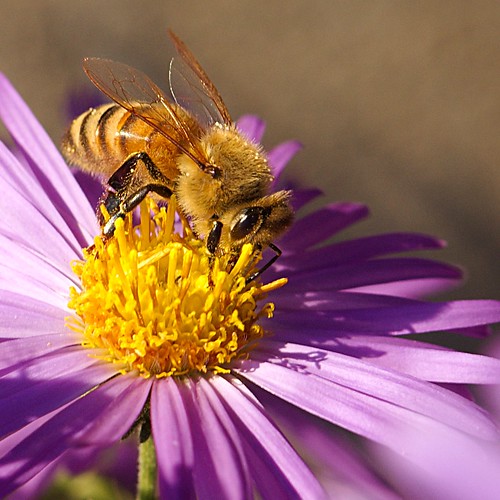Scoop some seriously wonderful vanilla ice cream into a small bowl.
Drizzle your favorite honey in golden rivulets over the ice cream.
Generously scatter toasted sesame seeds or toasted piñons on top.
Dust with cinnamon.
Thank the Bees.
Thank the Bees.
This goes well with Granny Stark's Shortbread Cookies, or any cookie, for that matter
Bees. Beautiful, bumbling, beloved and beleaguered. We fear them, we admire them, we need them. Their four translucent wings beat 11,000 times per minute, carrying them along a course pulled and pushed by perfume on the wind, with 5 eyes to appreciate the color of The Flowers, their intimate partners. For 140 million years flowering plants have bloomed, laid golden pollen down on sweet scented paths of wild color, their perfect petals a welcome path to the pollinators. A golden honeybee walks that silken road, wading in pollen, shaking it loose, rubbing it into her golden fur. Fickle (as she must be), she does her part by visiting 100 flowers in a foraging trip, finally to return to her hive carrying up to half her weight in pollen and nectar. She has a month or so on this Earth, and she spends it nectar drunk, flying, dancing in waggles, circles and trembles while her sisters harken and attend. For all her efforts, in her life she will give to her hive, her tens of thousands of sisters and her queen, about a 12th of a teaspoon of honey. For a pound of honey, that scales to: 10,000,000 foraging trips, 55,000 miles of bee-flight, and 2 million flowers bee-tasted. While they are at it, making their golden and glorious honey, the bees pollinate, and give us our crops, our orchards and our gardens. And wildflowers. Wildflowers in a meadow. Wildflowers lovely where you least expect them, in a crack in the asphalt, in a vacant lot. Bee-kissed wildflowers to carry you through a lonely moment.
 Bees are in trouble, and wild bees are disappearing. Colony Collapse Disorder and pesticides are taking a startling number of our honeybees. It possibly caused by a lethal combination of a mite, viruses, pesticides, thought better able to take hold when bees are stressed and weakened. And stress them we do, with our pesticides, agricultural monoculture, and habitat loss. We can help the bees in a simple joyful way by planting native wildflowers in our gardens, different kinds, in abundance. Pesticide-free bee habitat restoration, one yard at a time. Spring is coming – get busy.
Bees are in trouble, and wild bees are disappearing. Colony Collapse Disorder and pesticides are taking a startling number of our honeybees. It possibly caused by a lethal combination of a mite, viruses, pesticides, thought better able to take hold when bees are stressed and weakened. And stress them we do, with our pesticides, agricultural monoculture, and habitat loss. We can help the bees in a simple joyful way by planting native wildflowers in our gardens, different kinds, in abundance. Pesticide-free bee habitat restoration, one yard at a time. Spring is coming – get busy. Here is Taj Mahal and friends singing about Honeybees, music in case you feel the need to waggle dance while you're eating your honey and ice cream (I find I usually do...).
And here is a bee in a wild rose I encountered on a hike by Snoqualmie Falls, WA, in 2023:

No comments:
Post a Comment